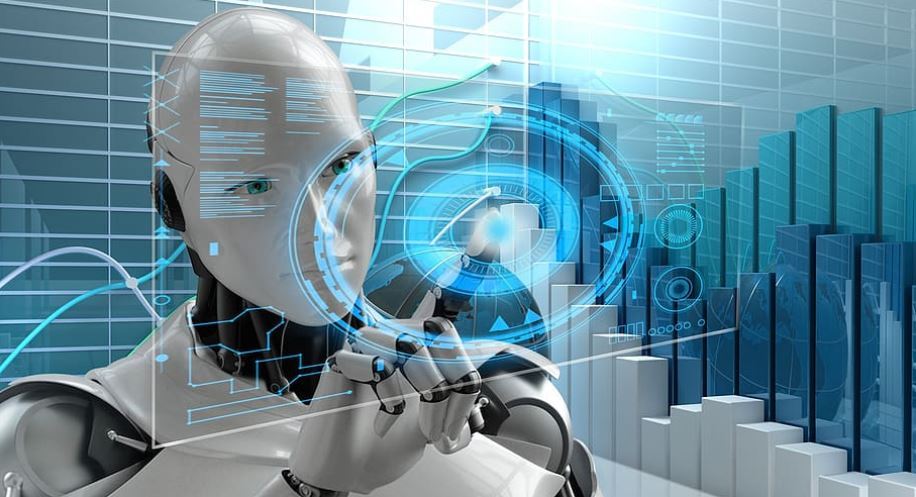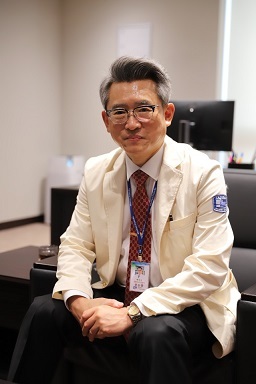
In March 2016, Koreans were stunned by the match between Alpha Go, an artificial intelligence program, and Lee Se-dol, a world-renowned Go champion. In many ways, the match marked a turning point in public perception of AI here. Domestic industrial applications of AI rose, including in the medical sphere.
This is an encouraging phenomenon, but without proper intervention, it may be too late to catch up with the US and China, which have more mature ecosystems of AI research and commercialization.
As the director of St. Mary Hospital, I have led many discussions in efforts to transform the institution into a “smart” hospital. The objective of this article is to relay my key takeaways.
AI innovations in the medical field can be categorized into three broad categories of image analysis and diagnosis, intelligent voice transcription and comprehensive prediction, prevention and treatment based on patient metadata.
The current state of innovation abroad lies in the first category -- image analysis and diagnosis -- which is already considerably robust. In a comparative study of breast cancer diagnostic accuracy, a trained algorithm outperformed 101 doctors specializing in image diagnosis with 92 percent accuracy. The accuracy for ophthalmic diabetic retinopathy was an astounding 99 percent.
According to a 2019 Nature Medicine article, an AI system was 94 percent accurate in diagnosing 6,716 lung cancer CT scan images. The accuracy of brain tumor diagnosis with MRI images, which are notoriously difficult to analyze, was over 85 percent, which surpasses the 66 percent accuracy rate of diagnosis by human brain specialists.
According to Google’s report, its program was 99 percent and 95 percent accurate in breast and lung cancer, respectively. Depending on the type of cancer, Google’s AI outperforms humans.
Image diagnosis using AI has advantages of quicker delivery and reduced burden on humans in terms of time and stress induced from manually synthesizing multiple images to make the best diagnosis.
Intelligent voice transcription has similar benefits. Most medical personnel spend an average of two to five hours creating medical records. AI voice transcription can dramatically reduce the time required.
Currently, over 500,000 doctors and nurses in the US use AI voice recognition software. Reports indicate that among doctors and nurses using such systems, burnout rate was reduced in half, fatigue was reduced by 70 to 80 percent and face-to-face patient treatment time was increased three to four times.
The third category -- comprehensive prediction, prevention, and treatment based on patient metadata -- is considered the holy grail of medical AI technology, with attempts such as IBM Watson. They remain a long way from replacing a human doctor, however.
AI can be broadly categorized into weak and narrow AI and strong and general AI. Programs such as Alpha Go are the former where the AI is built to excel at a very specific task. IBM Watson is an attempt at a general AI. Humans have yet to build general AI that can ingest different types of patient data and understand it and think like humans in making preventative decisions.
IBM Watson showed limited capacity for accurate diagnosing based on deep-learning technology compared to a human’s ability of integrated analysis. In cases of metastatic cancer that involves the entirety of the patient, diagnoses overlap between the computer and medical staff was at a low 56 percent with only 46 percent of metastatic cancer and 17.8 percent of metastatic lung cancer accurately diagnosed.
Domestically, most AI companies are focused on the first category of medical image analysis and diagnosis. Between 2017 and 2019, 13 medical AI software systems were developed in a variety of subfields such as brain imaging, bone age estimation, lung nodule detection, cerebral infarction, dementia diagnosis, cancer patient prognosis, breast cancer diagnosis, brain age measurement, chest image diagnosis and compression fracture diagnosis. They were licensed by the Ministry of Food and Drug Safety.
These companies had limited success, however, due to privacy regulations that stopped them from obtaining a sufficient number of images to train the programs. Every 1 percent drop in accuracy sets these companies back in the competitive marketplace.
As for intelligent voice transcriptions, Korean startups have an additional hurdle that their American counterparts do not encounter. Most Korean medical staff use a mix of English and Korean, and the situation is exacerbated by the fact that pronunciation of non-Korean terms is often inaccurate. Korean products have therefore had a difficulty achieving the 95 percent accuracy rate that similar products achieve in the US.
In the final category of comprehensive AI medical treatment, too little data is available for any development to happen. Several AI companies and hospitals have formed a coalition to tackle this issue, but the coalition is still at a nascent phase.
To enable rapid AI development in Korea, certain changes must take place. A large quantity of clean data is necessary, as are the legal steps to enable data exchange between medical institutions. There should be trained AI research teams at university hospitals and other higher-level general hospitals, and an investment in a targeted niche market specific to Korea to avoid competition with already advanced foreign competitors.
Experts predict that the AI industry will take off in the next 10 years. The development and commercialization of AI is poised to be one of the most important aspects of the future of medical science and technology. With proper incentives and government support, Korea has the potential to become a leading example in the world of medical AI.
As a final note, we should always remember that our efforts must serve the patient.
 By Kwon Soon-yong, president of the Catholic University of Korea Eunpyeong St. Mary's Hospital.
By Kwon Soon-yong, president of the Catholic University of Korea Eunpyeong St. Mary's Hospital.
This is an encouraging phenomenon, but without proper intervention, it may be too late to catch up with the US and China, which have more mature ecosystems of AI research and commercialization.
As the director of St. Mary Hospital, I have led many discussions in efforts to transform the institution into a “smart” hospital. The objective of this article is to relay my key takeaways.
AI innovations in the medical field can be categorized into three broad categories of image analysis and diagnosis, intelligent voice transcription and comprehensive prediction, prevention and treatment based on patient metadata.
The current state of innovation abroad lies in the first category -- image analysis and diagnosis -- which is already considerably robust. In a comparative study of breast cancer diagnostic accuracy, a trained algorithm outperformed 101 doctors specializing in image diagnosis with 92 percent accuracy. The accuracy for ophthalmic diabetic retinopathy was an astounding 99 percent.
According to a 2019 Nature Medicine article, an AI system was 94 percent accurate in diagnosing 6,716 lung cancer CT scan images. The accuracy of brain tumor diagnosis with MRI images, which are notoriously difficult to analyze, was over 85 percent, which surpasses the 66 percent accuracy rate of diagnosis by human brain specialists.
According to Google’s report, its program was 99 percent and 95 percent accurate in breast and lung cancer, respectively. Depending on the type of cancer, Google’s AI outperforms humans.
Image diagnosis using AI has advantages of quicker delivery and reduced burden on humans in terms of time and stress induced from manually synthesizing multiple images to make the best diagnosis.
Intelligent voice transcription has similar benefits. Most medical personnel spend an average of two to five hours creating medical records. AI voice transcription can dramatically reduce the time required.
Currently, over 500,000 doctors and nurses in the US use AI voice recognition software. Reports indicate that among doctors and nurses using such systems, burnout rate was reduced in half, fatigue was reduced by 70 to 80 percent and face-to-face patient treatment time was increased three to four times.
The third category -- comprehensive prediction, prevention, and treatment based on patient metadata -- is considered the holy grail of medical AI technology, with attempts such as IBM Watson. They remain a long way from replacing a human doctor, however.
AI can be broadly categorized into weak and narrow AI and strong and general AI. Programs such as Alpha Go are the former where the AI is built to excel at a very specific task. IBM Watson is an attempt at a general AI. Humans have yet to build general AI that can ingest different types of patient data and understand it and think like humans in making preventative decisions.
IBM Watson showed limited capacity for accurate diagnosing based on deep-learning technology compared to a human’s ability of integrated analysis. In cases of metastatic cancer that involves the entirety of the patient, diagnoses overlap between the computer and medical staff was at a low 56 percent with only 46 percent of metastatic cancer and 17.8 percent of metastatic lung cancer accurately diagnosed.
Domestically, most AI companies are focused on the first category of medical image analysis and diagnosis. Between 2017 and 2019, 13 medical AI software systems were developed in a variety of subfields such as brain imaging, bone age estimation, lung nodule detection, cerebral infarction, dementia diagnosis, cancer patient prognosis, breast cancer diagnosis, brain age measurement, chest image diagnosis and compression fracture diagnosis. They were licensed by the Ministry of Food and Drug Safety.
These companies had limited success, however, due to privacy regulations that stopped them from obtaining a sufficient number of images to train the programs. Every 1 percent drop in accuracy sets these companies back in the competitive marketplace.
As for intelligent voice transcriptions, Korean startups have an additional hurdle that their American counterparts do not encounter. Most Korean medical staff use a mix of English and Korean, and the situation is exacerbated by the fact that pronunciation of non-Korean terms is often inaccurate. Korean products have therefore had a difficulty achieving the 95 percent accuracy rate that similar products achieve in the US.
In the final category of comprehensive AI medical treatment, too little data is available for any development to happen. Several AI companies and hospitals have formed a coalition to tackle this issue, but the coalition is still at a nascent phase.
To enable rapid AI development in Korea, certain changes must take place. A large quantity of clean data is necessary, as are the legal steps to enable data exchange between medical institutions. There should be trained AI research teams at university hospitals and other higher-level general hospitals, and an investment in a targeted niche market specific to Korea to avoid competition with already advanced foreign competitors.
Experts predict that the AI industry will take off in the next 10 years. The development and commercialization of AI is poised to be one of the most important aspects of the future of medical science and technology. With proper incentives and government support, Korea has the potential to become a leading example in the world of medical AI.
As a final note, we should always remember that our efforts must serve the patient.
 By Kwon Soon-yong, president of the Catholic University of Korea Eunpyeong St. Mary's Hospital.
By Kwon Soon-yong, president of the Catholic University of Korea Eunpyeong St. Mary's Hospital.-
Articles by Korea Herald








![[KH Explains] Hyundai's full hybrid edge to pay off amid slow transition to pure EVs](http://res.heraldm.com/phpwas/restmb_idxmake.php?idx=644&simg=/content/image/2024/04/18/20240418050645_0.jpg&u=20240419100350)







![[From the Scene] Monks, Buddhists hail return of remains of Buddhas](http://res.heraldm.com/phpwas/restmb_idxmake.php?idx=652&simg=/content/image/2024/04/19/20240419050617_0.jpg&u=20240419175937)

![[KH Explains] Hyundai's full hybrid edge to pay off amid slow transition to pure EVs](http://res.heraldm.com/phpwas/restmb_idxmake.php?idx=652&simg=/content/image/2024/04/18/20240418050645_0.jpg&u=20240419100350)

![[Today’s K-pop] Illit drops debut single remix](http://res.heraldm.com/phpwas/restmb_idxmake.php?idx=642&simg=/content/image/2024/04/19/20240419050612_0.jpg&u=)